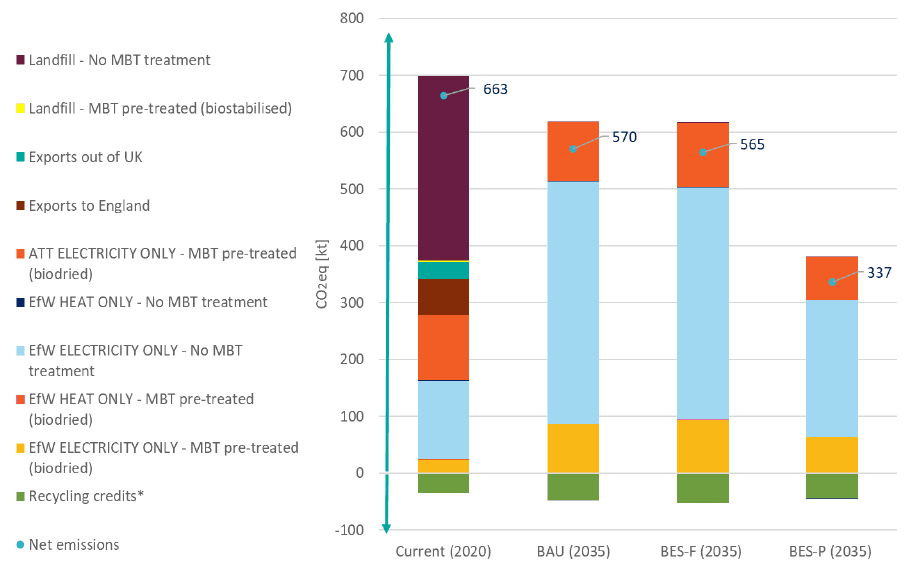Decarbonisation of residual waste infrastructure: report
Second report and supporting documents from the Independent Review of the Role of Incineration in the Waste Hierarchy in Scotland (Stop, Sort, Burn, Bury?), on decarbonisation of residual waste infrastructure in Scotland.
2 Approach to the Second Report
2.1 Overview of the Second Report Process
This Second Report, as part of the Review, seeks to evaluate the opportunities to decarbonise the residual waste treatment infrastructure sector in Scotland and in doing so considers the following questions:
- What does the current carbon impact of disposal of waste look like?
- What are the possible options to decarbonise residual waste infrastructure?
- What are the most effective and feasible options to improve existing waste management infrastructure in terms of carbon performance?
- What combination of options is the most feasible for Scotland?
The scope of the Second Report is residual waste infrastructure, for the treatment of household (HH), and commercial and industrial (C&I) waste[8], with a focus on waste incineration infrastructure (including that in construction and likely to be developed). Both technology changes as well as systematic changes to decarbonise infrastructure are considered. In preparing the Second Report, the Review team considered stakeholder feedback gathered through the initial Call for Evidence, which is summarised in the evidence document[9] published alongside the First Report, and two stakeholder events. The review also received a report from Eunomia, which set out to assess the effectiveness of options to decarbonise existing waste infrastructure.
2.2 The Eunomia Report
In December 2022, Eunomia presented the results of its commissioned work, and that report is published alongside the Review’s Second Report [10]. This work assessed the effectiveness of options to decarbonise existing waste infrastructure (the ‘Eunomia modelling report’). The overarching objectives for this work were to:
- Evaluate (GHG) emissions for existing residual waste management facilities within scope;
- review additional and alternative technologies to the current systems in use, with particular focus on the existing incineration facilities, by assessing the viability and potential impact of each option – including its technical, environmental, economic and social impacts, together with its limitations and risks; and
- provide a high-level commentary of each of these options to decarbonise the existing residual waste facilities, and how these paths would change over time.
To compare the carbon impact of implementing options to decarbonise the residual waste sector, Eunomia developed a baseline for carbon impacts associated with residual waste treatment, covering:
- Direct emissions such as those arising from the combustion of waste streams;
- Impacts arising from energy use at facilities;
- Avoided emissions arising as a consequence of energy being generated via the waste management process (e.g. energy generation at incinerators) which therefore negates the requirement for energy to be generated elsewhere and emissions avoided by dry recycling (for incinerators, this relates to the recovery of metals from bottom ash).
The baseline and scenarios also included sequestration of biogenic carbon in landfills.
The baseline examined the current carbon impacts of managing residual waste, and the carbon impacts of managing residual waste in 2035 under three scenarios, Business as Usual (BAU), Best Efforts Scenario - Food (BES-F), and Best Efforts Scenario - Plastics (BES-P). The BAU scenario predicts increases in recycling rates comparable to the BAU scenario in the capacity modelling undertaken in the First report. The BES-F and BES-P scenarios mirror the improvements in recycling rates of the ‘Best Efforts Scenario’ from the capacity analysis in the First Report, but acknowledge that there are multiple ways to achieve improvements in recycling rates. The BES-F scenario forecasts greater improvements in food waste recycling, and the BES-P scenario forecasts greater improvements in plastics recycling. These scenarios thus act as a sensitivity analysis for the impact of potential options.
Each scenario was modelled to 2035. This year was selected to balance the desire to forecast as far into the future as possible to enable policy impacts to take effect and facilities and infrastructure (e.g. heat networks) to feasibly be developed with the increasing uncertainty in future years, particularly due to changes in waste composition and quantities, and the energy grid impacts. Figure 1 shows the estimated annual residual waste emissions of the baseline scenarios (2020 and 2035), before any pathways were applied.
The first draft of the Eunomia report was also considered by the Climate Change Committee (CCC) and revised in light of the comments received.

The Review considered a long-list of options to decarbonise the residual waste sector, discussed below in Section 4, and from this, identified four pathways which, based on stakeholder feedback and evidence, it considered could most feasibly decarbonise the sector:
- Advanced sorting;
- Advanced sorting and the deployment of heat networks;
- Advanced sorting and the deployment of CCUS; and
- Advanced sorting and the deployment heat networks and CCUS.
The deployment of heat networks and of CCUS was modelled on a best case basis – this represents the most these could do to help decarbonise incineration.
The results of the Eunomia report underpin the discussion in Section 4 and are set out in more detail in Section 5.
Contact
Email: zero_waste_inbox@gov.scot
There is a problem
Thanks for your feedback